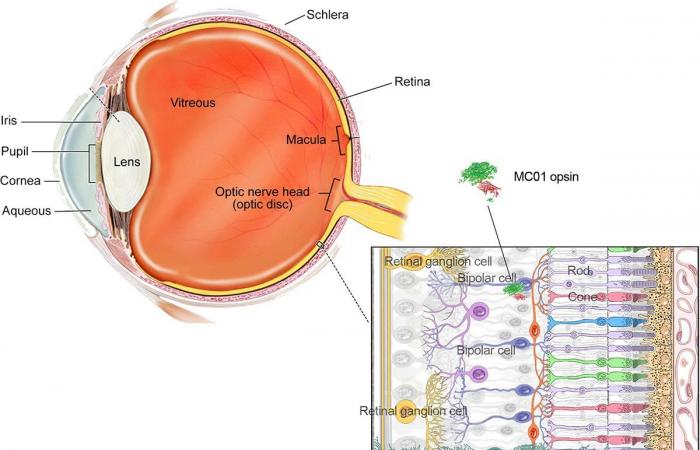The detail shows the structure of the retina, including the location of a bipolar cell that expresses the MCO1 opsin from Nanoscope. Photo credit: National Eye Institute
Scientists are using gene therapy and a novel photosensitive protein to restore eyesight in mice. The NIH-funded therapy is now being tested in humans.
A newly developed light-sensitive protein called MCO1-Opsin restores the vision of blind mice when it is bound to bipolar retinal cells by gene therapy. The National Eye Institute, part of the National Institutes of Health, awarded Nanoscope, LLC a Small Business Innovation Research Fellowship for the development of MCO1. The company plans a clinical trial in the US later this year.
The results of the nanoscope were presented today in Nature gene therapyshow that completely blind mice – meaning they have no light perception – regain significant retinal function and vision after treatment. Studies described in the report showed that treated mice performed significantly faster on standardized visual tests such as navigating mazes and detecting changes in movement.
Opsins are proteins that other cells signal as part of a signal cascade that is essential to visual perception. In a normal eye, opsins are expressed by the rod and cone photoreceptors in the retina. When activated by light, the photoreceptors pulse and send a signal via other retinal neurons, the optic nerve, and on to neurons in the brain.
A variety of common eye diseases, including age-related macular degeneration and retinitis pigmentosa, damage photoreceptors and affect vision. While the photoreceptors may no longer function fully, other retinal neurons, including a class of cells called bipolar cells, remain intact. The researchers identified a way for bipolar cells to do some of the work of damaged photoreceptors.
The nanoscope researchers Samarendra Mohanty and Subrata Batabyal. Photo credit: Nanoscope
“The beauty of our strategy is its simplicity,” said Dr. Samarendra Mohanty, founder of Nanoscope and corresponding author of a report on the mouse study that appears in today Nature gene therapy. “Bipolar cells follow the photoreceptors. So when the MCO1 opsin gene is added to bipolar cells in a retina with non-functioning photoreceptors, the photosensitivity is restored. ”
The strategy could address challenges plagued by other approaches to retinal regeneration, according to the researchers. So far, gene replacement therapy has mainly worked for rare diseases in which photoreceptors remain intact, such as Luxurna for congenital liver amaurosis. Bionic eyes like the Argus II retinal prosthesis require invasive surgery and wearable hardware. Other opsin replacement therapies require the intensification of light in order to reach the threshold necessary for signal transmission. However, intense light can further damage the retina. The therapy of the nanoscope requires a single injection into the eye and no hardware. MCO1 is sensitive to ambient light, so no strong light shines into the eye. Therapy with MCO1 could treat a wider range of retinal degenerative diseases as photoreceptor survival is not required.
The researchers found no safety issues in treated mice. Examination of the blood and tissues showed no signs of inflammation due to the treatment and the therapy had no out-of-target effect – only bipolar cells expressed the MCO1-opsin.
At best, the therapy could help patients achieve 20/60 vision, the researchers said. However, no one knows how restored vision compares to normal vision.
“A human clinical study will help us understand how signal transmission by bipolar cells affects visual quality. For example, how well-treated eyes can detect fast-moving objects, ”said Subrata Batabyal, Ph.D., lead author of the manuscript. Therapy will likely be limited to treating patients with severe retinal disease.
“If this optogenetic approach, using cells spared in the degenerated retina, can prove effective in restoring vision beyond light perception in humans, it could be a valuable alternative to the retinal prosthesis approach for people with retinitis pigmentosa Late stage, ”said PaekGyu Lee, Ph.D., NEI program director for the Small Business Innovation Research program.
Reference: October 21, 2020, Nature gene therapy.
DOI: 10.1038 / s41434-020-00200-2
This press release describes a basic research result. Basic research improves our understanding of human behavior and biology. This is the basis for the further development of new and better methods for the prevention, diagnosis and treatment of diseases. Science is an unpredictable and incremental process – every advance in research builds on previous discoveries, often in unexpected ways. Most clinical advances would not be possible without knowledge of basic research.
These were the details of the news Scientists use gene therapy to restore vision in blind mice –... for this day. We hope that we have succeeded by giving you the full details and information. To follow all our news, you can subscribe to the alerts system or to one of our different systems to provide you with all that is new.
It is also worth noting that the original news has been published and is available at de24.news and the editorial team at AlKhaleej Today has confirmed it and it has been modified, and it may have been completely transferred or quoted from it and you can read and follow this news from its main source.

